Wildlife Removal Blog 2006
This weblog chronicles some of the adventures I have had while operating my wildlife removal company in Orlando, FL - Click any of the photos for a larger image and more information.
I currently have 351 blog entries. You can select them sorted as such:
2003 •
2004 •
2005 •
2006 •
2007 •
2008 •
Armadillo •
Bat •
Bird •
Dead •
Opossum •
Rat •
Snake •
Squirrel •
Others •
Repairs •
All Entries
12.25.2006 - Christmas Squirrel - Ben Saves the Day
 |
|
| 'Twas the night before Christmas, when all through the house. A creature was stirring, a rat squirrel or mouse. The stockings were hung by the
chimney with care, but unfortunately of people the apartment was bare. The squirrels were all nestled all safe in their beds, while visions of peanuts danced in their
heads. Alas one poor squirrel did not make a peep, because it was stuck in a permanent sleep. Thus from the walls arose such an odor, that Ben jumped in his truck and
turned on the motor. The stench in the house from the walls that arose, gave the luster of ...click for more |
12.19.2006 - Squirrel Questions and Answers
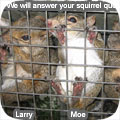 |
|
| Dear Three Squirrels, I was on your website and I had a question for you. How can I tell by sound if I have a squirrel or a mouse in my wall?
Some history: I have a new home. It’s only 4 years old and for the four years I’ve been in my home I’ve been plagued with critters in my wall. I know for a fact one of the nuisance was field mice. They would
come in late fall and leave late spring (every year). I believe I pretty much have that problem under control. I found some gaps that the builder didn’t close (no roof sheeting behind the gutter in a couple of
spots, didn’t caulk whe ...click for more |
12.18.2006 - How to Trap a Rat in a Cage
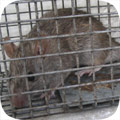 |
|
| Suppose you want to trap rats in a cage, as opposed to using snap traps. It can be done. I personally stick to snap traps most of the time, for a variety of reasons both practical and strategic. However, there are times when I do cage trap rats. The few times I've
done so have been by customer request. The principles for cage trapping are the same as for snap trapping. To trap a rat in a cage, set the cage in the right place. Rats tend to use the same paths and runways over and over again. These areas are easy to spot, because the rats leave
behind droppings, urin ...click for more |
12.11.2006 - Soffit Repair To Keep Critters Out of Attic
 |
|
| One of the most common areas that animals use to enter an attic is the soffit. The soffit is technically the bottom of the eave. Most homes have
aluminum or vinyl soffits, in track form, held in by J-channels affixed to the eave and the wall. Some homes have wooden soffits. Most soffits have some form of
ventilation - holes in the aluminum, or separate vents in the wood, or even a ventilation strip running the length of the soffit, with a screen. Most soffits are
vulnerable to animal entry, and given the architecture of a house, the eave leads right into the attic, where ani ...click for more |
12.06.2006 - Florida Brown Snake
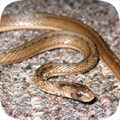 |
|
| The Florida Brown Snake Storeria victais is tiny, and it rarely grows to longer than a foot in length. It ranges throughout most of the Florida peninsula. It's not a very common snake, and because of its small size, boring brown color, and reclusive
nature, it's not commonly seen. It's a member of the common colubrid family of snakes, it's active during the daytime, it mostly eats bugs and little amphibians and reptiles such
as anoles, and it give birth to live young in the summer. It's not venomous. I caught this lovely specimen in one of my snake traps, ...click for more |
11.30.2006 - Guinea Hen Capture
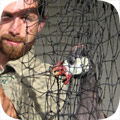 |
|
| Now here's a new catch! A Guinea Hen! I suspect that this fine bird was someone's pet, and then it either escaped or was abandoned. Either way, it wound up living on the steps at an apartment complex that I regularly service. This time, instead of
removing squirrels from the attic 3-stories high, I removed this feathery friend. Apparently the maintenance crew tried repeatedly to catch it and chase it away, but it stubbornly resisted capture and chasing, and had been living on a particular flight of stairs for
approximately a week, and thus I was called onto the sc ...click for more |
11.28.2006 - Green Anole
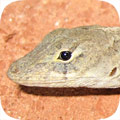 |
|
| The Green Anole, (Anolis carolinensis) is also called the Carolina Anole. It lives in the southeast US and throughout Florida. This small lizard can grow to about eight inches. Males are larger than females and have a throat fan, or dewlap. This lizard
can change color to match its background, and they eyes can move independently, like a chameleon. They eat a variety of small prey, mostly insects. If attacked, they can detach their tail in hopes that a predator will go for that as opposed to the more
vital parts. They can live up to seven years in captivity, but probably ...click for more |
11.25.2006 - Dead Animal Under the Floorboards
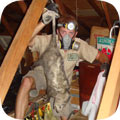 |
|
| "I have a dead rat in my ceiling", the call began. The calls usually do not begin correctly. "Okay, I will come to your house and remove the dead rat" I said. I don't bother to tell the caller that he is possibly
wrong. A bad smell in the home can mean a number of possibilities - 99% of the time it is in fact a dead animal. However, which animal might it be? Oh, this is where the delightful sleuthing and treasure hunt begins.
In this case, I entered the attic, and smelled it right away. Thus, I knew that it probably wasn't a rat. Rats tend to die under the insulation, and the smell per ...click for more |
11.19.2006 - Trapper Apprentice - Learning How To Trap Wildlife
 |
|
| I have a new apprentice training with me. His name is Ben, and already he's shaping up to be a fine wildlife removal specialist. He's demonstrated a
willingness to climb into hot attics, crawl under dirty homes, and sniff out dead animal carcasses. He doesn't mind getting his hands dirty, that's for sure! Here's
a list of the traits that make a good wildlife trapper apprentice: Common Sense - Probably the most important thing, outside of being a good person, and
not everyone has it of course. I don't care if someone has a fancy pants degree in wildlife biology. ...click for more |
11.12.2006 - Mummified Bat
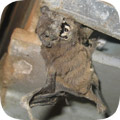 |
|
| Look at this fine looking fellow. It's a mummified bat. I've named him Gordon Marion Butler III for unspecified reasons. It was quite the delight to see this sight at night, when I shone my bright light just
right, it looks like it might take flight and bite. Oh, Gordon, you zany mummified bat. If anything, this specimen proves one thing - no, not that bats, Gordon in particular, are handsome, but that they can really cling to
stuff. I mean, if you expire and you're still hanging on for dear life, ur death, then you've got a good grip on things. Bats are downright sticky. I guess ...click for more |
11.04.2006 - How Do You Trap An Armadillo?
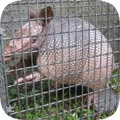 |
|
| "How do you trap armadillos?" Many an exasperating phone conversation starts with this question on the other end of the line. Even though I have gone to great lengths to make it explicitly clear that I simply do not
want every yokel across the country calling me with nuisance wildlife questions - after all, when you call me, I WILL be engaged in one of the following activities: sleeping, driving, working on a roof, or working in
an attic - seriously, these are the only things I do. Sometimes I eat or type on my computer. Okay then, so I'm doing one of these things, when I get the ...click for more |
11.03.2006 - Raccoon Trouble Emails
 |
|
| Dear David- Greetings from Maryland. Your photos are dynamite and you certainly appear to be someone who is excellent in your profession, and enjoy the humane trapping and relocating of wildlife from domestic residences back to the wild.
We have been 'tracking' a raccoon(s) through our basement and in between first and second floor rafters for several weeks. This evening we successfully trapped an adult raccoon in a Havaheart trap and released it about 10 miles out of town in the woods.
The animal was unharmed in trapping, and appeared healthy, and ...click for more |
11.02.2006 - Removal of a Hawk From Aeropostale Store
 |
|
| I got a call today about a hawk stuck in a retail store. I arrived on the scene - a trendy shopping district in Orlando, and entered the address - an Aeropostale clothing store. Sure enough,
I saw a hawk perched amongst the rafters at the ceiling of the building (see upper left). Apparently the store managers had left the door open, and the bird was flying low and erratically because it was carrying its
favorite prey in its talons: a pigeon. Perhaps other pigeons were chasing the hawk (a behavior I've seen several times, once a hawk has a victim in its claws) & the hawk ...click for more |
10.25.2006 - Wildlife Relocation
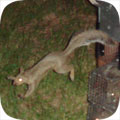 |
|
| Here is Tim, releasing some squirrels into a wildlife preserve area. These animals were caught and removed from an attic in a suburban home.
We perform live trapping and relocation of all our wildlife that we catch, so long as it's legal to do so. We always strive to put the animals under the least amount of
stress possible. We never leave animals in the sun, we don't leave them in traps for long, and we always relocate them same day. However, what is the right way to
relocate wildlife? It's possible that we are in fact putting them under a lot of stress by tak ...click for more |
10.22.2006 - Florida Scarlet Snake
 |
|
| This is a Florida Scarlet Snake - Cemophora coccinea coccinea. They're not terribly common here in central Florida, at least as far as I've seen. This is probably because they're primarily nocturnal
and spend most of their time under heavy debris and rocks and other cover. This snake is not to be confused with either the Scarlet Kingsnake or the Coral Snake. Regarding the latter, the venomous one, it's important
to realize that the Scarlet Snake is a harmless mimic, and is, in my opinion, very ...click for more |
10.11.2006 - Wildlife Rescue in Orlando Florida
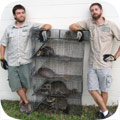 |
|
| If you are seeking wildlife rescue for a wild animal in Orlando, you probably won't get free help to rush on out and take care of it for you. There are some wildlife rehab centers and individuals operating in the Orlando area, but
they don't do house calls. You have to bring the animal in to them. One of the frustrating aspects of running my own wildlife removal business is that many people call me thinking that I'm some government sponsored agency, and that I will come to the
property for free to take care of some wildlife malady. Many of these callers assume that the ...click for more |
10.10.2006 - Florida Exotic Species - Iguana, Burmese Python
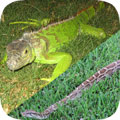 |
|
| One of the more common sensationalist topics in the field of wildlife management is that of exotic species. Exotic means non-indigenous, or non-native species. In particular, people are interested in large and scary critters such as giant lizards and snakes. In my field of nuisance wildlife control, I come across exotics commonly. The above photo shows two of the interesting exotics that I've dealt with over the years: the iguana, which is native to Central and South America, and the Burmese Python, which comes from southeast Asia. I caught these animals in suburban ...click for more |
10.05.2006 - A Nest of Baby Rats
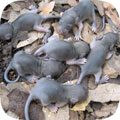 |
|
| This is a litter of baby rats that I removed from the gutter of a home. The homeowner had actually observed the female rat entering and exiting the gutter, and suspected a nest therein. I arrived at the home,
and found the gutter of the porch roof completely littered with years' worth of debris, much of which was so old it had nearly decomposed into soil.. I began to dig through and remove and bag the debris, when one of my
scoops yielded a SQEAK- SQEAK- SQEAK noise, and I knew I had hit paydirt. By paydirt I mean rats in dirt, for which I got paid. I carefully ...click for more |
10.03.2006 - Preventing Squirrels from Getting in the Attic
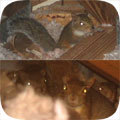 |
|
| Here's a couple of squirrels that I've managed to photograph inside attics. I've already written many guides about how to remove squirrels from attics, so
now I will just write about how to prevent squirrels from getting into your house in the first place. Of course, if you've found my website, it's likely that you already
have a wildlife problem, but I'll write about prevention anyway. If your already have a squirrel problem you can certainly do preventative measures to prevent future problems
from happening again. Step 1 Inspect the whole house, top to bottom, and ...click for more |
10.01.2006 - Brown Water Snake
 |
|
| I caught this Brown Water Snake, Nerodia taxispilota, on the shores of Lake Maitland, FL. Many people confuse this snake with the
venomous Cottonmouth, or Water Moccasin. The Brown Water Snake is, of course, an aquatic snake, just like the Cottonmouth. Most aquatic snakes have bulky
bodies. And of course pretty much all snakes have triangular heads larger in size than their necks. Thus, this snake does mimic the body shape of the
cottonmouth, in addition to sharing its habitat. However, the snake is not venomous. It does give birth to live young ...click for more |
09.27.2006 - Florida Armadillo Control
 |
|
| Here's a nice blurry shot of my friend Tim and I with some armadillos that we caught today. They've been very active lately, digging large burrows under homes. Most armadillos that I deal with tend
to dig underneath homes. However, in this particular case, the armadillos were digging under a deck. They must have moved about 500 square feet of dirt in this case. The mound of sand/dirt outside the tunnel was simply
huge. We had to work to climb over it. The homeowner didn't want the armadillos because they removed so much dirt out from under the deck, and the ...click for more |
09.25.2006 - How To Catch Squirrels
 |
|
| The best way to catch squirrels is with a cage trap. There are lethal traps available, but there's no need to kill squirrels, and lethal traps are
dangerous to use, and in my opinion, less effective than cage traps. In the above photo, I'm holding three types of cage traps. The two traps on top are Havahart
1045 traps. They work well, but they are limited to flat areas with enough room. The door slides up vertically, and it needs enough space. It comes down due
to gravity when a squirrel steps on the trip pan and a bar triggers the door to slide down and shut. The next two pict ...click for more |
09.24.2006 - Ugly Opossum
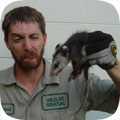 |
|
| Some people think opossums are cute. Some people think they are ugly. In the case of this specimen, it's the folk in the ugly camp who are correct. This possum so ugly when it joined an ugly contest, they said "Sorry, no professionals." This possum
so ugly just after it was born, its mother said "What a treasure!" and its father said "Yes, let's go bury it." This possum so ugly its fleas wear paper bags over their heads. I showed this photo to a friend of mine and said how ugly it was, and she agreed that the subject
wasn't very cute, but that the critter looked fine, and I didn't ...click for more |
09.22.2006 - Wildlife Jobs in Florida
 |
|
| If you are seeking a job working with wildlife in Florida, there are several options. You can work for a local county animal services, where you will deal mostly with dogs and cats. You can work with the Florida Wildlife Commission, where you
will probably not get a job, and if you do, it'll probably be something specialized, or perhaps a desk job. I'm not sure. Contact them at www. floridaconservation .org. You can also seek to be employed by a
privately owned wildlife removal business. There are several such businesses in Florida, such as Skunk Busters, Kreature Katch, Trap ...click for more |
09.21.2006 - Rat Catching - How to Catch a Rat
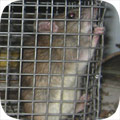 |
|
| This job took place in the ceiling of a church. The man who hired me was not the minister, or the organist, or the acolyte, or the little old lady with the blue hair who never misses a Sunday. I'm not sure exactly what he was, but he's probably the creepiest
customer I've ever had to deal with, and he told me to catch rats and squirrels from the attic. So I did. The attic of this church did have a major infestation of both rats
and squirrels. The people inside the church could hear them all the time. The attic was filled with rodent droppings. Because of the presence ...click for more |
09.20.2006 - Florida Ringneck Snake
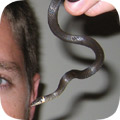 |
|
| The Florida Ringneck Snake is one of the most commonly removed nuisance snakes in the state of Florida. Of course, it's as harmless as an
earthworm. The reason I encounter this snake so often is because it is not only common, but small - and thus it commonly squirms through very small gaps and
into houses. It is the single most commonly encountered snake inside the home here in FL. Snakes explore their habitat, and often squirm through small gaps,
and thus it often finds small holes under doors or other areas, and slithers into a house, and then can't find its ...click for more |
09.18.2006 - Coonskin Cap
 |
|
| I wanted to wear a coonskin cap, to imitate Davey Crockett. I wondered if I should set a trap or pay for one out of pocket. If I bought the hat, what's the sport in
that? And what about my wallet? Shell out the scratch, or make a catch - it's heads or tails - you call it. If I set a trap and caught a coon, then I'd have to skin it. That'd make me feel like a goon. I thought it
over for a minute. What if, I thought, I made the catch, thus saving me some dinero? But then I chose not to dispatch, Thus making me a hero? Ah, I thought, now that's the ticket, have my cake and eat it too. So I ...click for more |
09.11.2006 - Baby Coral Snake
 |
|
| This is a juvenile hatchling Eastern Coral Snake. It's probably a month old at most. Whereas some snakes will constantly slither all over the place, corals will often hold still in one position. I was in a good mood,
so I decided to drape it over my nose. I sent this photo to a friend, who claimed that I must be crazy, as he had heard that the venom of juvenile snakes is more potent than that of adults. I replied that I do not
think this is true. The composition of the venom does not change over the lifetime of the reptile. Although it's true that the neurotoxic venom of the Coral Snake ...click for more |
09.09.2006 - Critter Catcher in Training
 |
|
| Ah, yet another disgruntled software engineer who's decided to take a walk on the wild side. I myself used to be a software developer, hating my life
behind the desk staring at a computer screen (oh wait, that's what I'm doing at this very moment), but when I discovered the fun of working outside catching critters, I haven't
looked back. My friend Tim decided that he'd like to do the same thing, so now he's down here with me in Florida, training to be a critter catcher himself. He wants
to open his own operation in Portland after six months or so with me. Tim is one of ...click for more |
09.07.2006 - Pine Woods Snake
 |
|
| This is a Pine Woods Snake, (Radinaea flavilata). It is an uncommon snake. It lives throughout most of the Florida peninsula and spotty areas throughout the SE coast, but it's not very common. It's an orange/rust/pinkish colored snake that
spends most of its time under debris, eating bugs and little lizards and stuff like that. It rarely grows to more than 14 inches, and this one was about 10 inches. The only reason I'm even bothering to write about it is because it was a new snake find for me.
It looks similar to the SE Crown Snake or the Florida Brown Snake, both of which ...click for more |
09.05.2006 - How To Remove Cats in the Attic
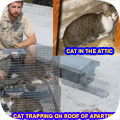 |
|
| Cats in the attic! Cats in the attic! All I keep hearing about is cats in the attic. Meowing and scratching! Prowling and mouse catching! Howling and rat snatching! Well, not howling so much. But yeah, cats in the attic. I remove
all kinds of wild animals from attics: raccoons, squirrels, opossums, rats, bats, and even cats. Most of the time, the customer hears scratching and scampering and clawing in the attic. But sometimes they also hear mewing. If they hear mewing, I have reason
to suspect that they have cats, for cats howl and mew. If they do have cats, what ...click for more |
09.03.2006 - Florida Pigeon Control
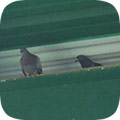 |
|
| This is a typical example of a pigeon problem at an urban building. In this case, it was an auto repair shop in Orlando. I have split the
photo into two parts - on the top is the area where the pigeons roost on steel beams below a metal roof. Below is the ground that is covered with pigeon
droppings. The owners of the auto store clean the droppings often, but the birds keep making a fresh mess all the time. Pigeons are a common problem bird
in Florida. Specifically, the urban pigeons that cause these problems are often called Feral Pigeons or Rock Pigeons, and even ...click for more |
08.24.2006 - Orlando Rattlesnake
 |
|
| Here's an Orlando Rattlesnake - With diamonds on its back - Please, dear reader, make no mistake - It has a most deadly attack
- It's armed with hypodermic fangs - And a nasty disposition - Upon my trusty hook it hangs - In a compromised position - But if you see it on the ground - And if you get too
close - Soon, my friend, you will have found - Yourself with a lethal dose - You may have seen the warning signs - The coiling and the rattle - Because before this serpent
dines - Its tail begins to tattle - Let that serve as ample warning - For you to back away - Wake up ...click for more |
08.20.2006 - Groundhog Trapping
 |
|
| Groundhog trapping, in Florida of all places? No, I have to admit that I did not trap this groundhog at all. It was captured by my good friend Bruce, who lives on Massachusetts. The critter was digging under his porch and eating his plants, and
he finally decided that it had to go. He called me to ask for my expert advice. I carefully described a trap consisting of an apple under cardboard box propped up by a stick to which a string is tied. Bruce is so trusting, that he set up said configuration, and waited
many frustrating hours patiently waiting for the groundhog ...click for more |
08.16.2006 - A Giant Colony of Bats in the Attic
 |
|
| Sometimes I see a case of wildlife gone wild so severe, that I wonder what the devil the homeowner was thinking. It's like the guy who sits down in the dentist's chair and has 16 cavities in the seven teeth
he's got left. Why was it not addressed earlier? I encountered such a case today when I came upon a large colony of bats living in an attic. This is a colony composed entirely of Brazilian Free-Tail bats. I estimate
the size of the group in the range of 1500-2000 members. The full photo apparently contains 91 individual members (according to my expert bat counter). ...click for more |
08.12.2006 - Removal of a Dead Opossum in the Wall
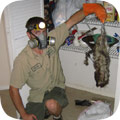 |
|
| I liked this job. I was called to this house due to the horrible odor. Sometimes the dead animal odor is faint, and this one aint.
What's the past-tense of aint? Waint? Anyhow, as usual, I sniffed and I snuffed, searching for the dead animal. I had no attic space to investigate, so I
had to keep my nose on the walls. The smell was strongest in the kitchen. It's usually pretty hard to pinpoint dead animals inside walls. But I'm really
good at it. I found the wall with the strongest odor, and as luck would have it, I could make my incision from inside the kitchen closet, thereby making...click for more |
08.01.2006 - How To Get an Animal Out of a Tree
 |
|
| The man in this photograph is not me. In fact, it might not be a man at all - more like a monkey. I'd never make a climb this high or dangerous, let
alone with a snare pole in hand, let alone back down with a struggling raccoon on the end! But that's what my friend Sean did to catch this raccoon in a tree. The
customer called because this particular raccoon has been causing trouble. Breaking into the attic, tipping over the garbage can, and always out and about during the day
threatening her dogs, and so on. So when she saw it, Sean came out to catch it, and it ran up a ...click for more |
07.27.2006 - Cuban Tree Frog in Florida
 |
|
| These frogs are everywhere here in Orlando Florida. When I arrive at a house, I often see them perched on the walls or atop the door, or light fixture, or many other areas. When I conduct an inspection of the roof, I often find several more. I routinely
see them down inside the plumbing stacks of homes. For the most part, they are harmless. However, some people simply don't like frogs, or even have phobias, so from time to time I am called to address frog issues. I've had a couple of cases of frog-in-the-toilet, and I
think that the frogs may have gone down the ...click for more |
07.26.2006 - Snake Eating Squirrel
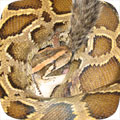 |
|
| I caught this eleven foot Burmese Python yesterday. I was also called to remove a freshly killed squirrel today. I noticed
that the snake was rather thin, with ribs showing and everything, so I figured, "why not?" and I threw the snake the squirrel. I've never kept snakes before as pets, nor do I
know anything about feeding snakes. I left the room and went to do some computer work, and when I came back to check, it was swallowing the squirrel! I took this photo of the
process. The snake had wrapped all around the animal, and was just slowly swallowing it. It was fascinating ...click for more |
07.25.2006 - Burmese Python in Florida
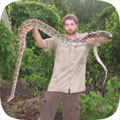 |
|
| This is the largest snake that I've ever caught as a wildlife control operator. At 11 feet in length, it's the longest animal that I've ever caught as well, even longer than that ten foot squirrel I once got. This is a Burmese Python
(molurus bivittatus). It's native to the rainforests of southeast Asia. It's one of the largest species of snake in the world, and the largest known specimen so far is 27
feet long and 400 pounds. I guess that makes the one I just caught seem small, but still, that's one big snake that I caught. I got the call from an apartment complex, and the
snake was actually ...click for more |
7.18.2006 - Attic Cleanup - Remove Wildlife Waste & Poop
 |
|
| In the above photo I'm spraying the attic with my atomizer to destroy the animal waste. I usually wear a biohazard suit, but this attic was about 150 degrees in the Orlando July, so I skipped it. Not a good idea, but I showered immediately afterward, and I always wear my HEPA filter mask. This attic had rats, and the brown chipped insulation, which meant that I couldn't see all the droppings very well, nor vacuum them. This fogging machine, also called an atomizer, sprays my cleaning solution in a fine mist that permeates the entire attic, and makes certain attic cle ...click for more |
07.12.2006 - Chicago Raccoon Job Emails
 |
|
| Dude, your site is awesome and helped me SO MUCH. I just did get rid of a raccoon in an attic above my kitchen. We used a live trap and some tuna and caught it and then took it over 10 miles away and released
it into the forest preserve. I am in the process of looking for a company to go up in there now and remove all the insulation and shit that this thing left up there. I was considering putting on a mask, gloves and going up there and doing it myself, but after
reading your site I'm thinking maybe I should let professionals do it. YOU HAVE BALLS man. lol Some of ...click for more |
07.11.2007 - Tokay Gecko In Florida
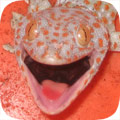 |
|
| We got a call about a very strange sound that came from the walls of a home every night. We get calls about animal noise all the time - that's usually the first symptom of animal infestation that people notice. However, most of the sounds are standard
scurrying or scratching in the attic. Sometimes people hear running on the roof, and sometimes they hear the chattering of baby raccoons. However, in this case they heard a loud croaking/squawking sound and a tooting not unlike a kazoo. It was driving them crazy and keeping
them awake all night. At a loss for wh ...click for more |
06.29.2006 - Chimney Swift Removal
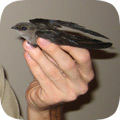 |
|
| Each June, I receive many calls about a terrific racket coming from inside a chimney. I've heard all sorts of explanations, everything from "family of squirrels" to "there's a rattlesnake in my
chimney!". These explanations are wrong. It's Chimney Swifts (Chaetura pelagica). The Chimney Swift is one of North America's more remarkable birds. They are fantastic fliers: they catch their food, insects, on the wing,
and even snatch up nesting twigs on the wing. They use these twigs to build a nest, which they adhere to the wall of a cavern using special sticky saliva. In nature ...click for more |
06.27.2006 - Mouse Nest In Attic
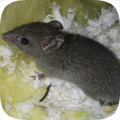 |
|
| One of the reasons rodets such as rats and mice enter an attic is in order to have a place to create a nest and have babies. This is actually the primary reason certain animals, like raccoons and opossums use attics. Rodents tend to use attics regardless, but
as with any animal, they create their nests in convenient and safe places, so if you have rats or mice in your attic, there's a good chance that some of the adult females have created nests. I've seen several different rat and mouse nests in attics so far. The nest usually
consists of a cluster of shredded debr ...click for more |
06.21.2006 - Attic Insulation Replacement Vacuum Cleanout
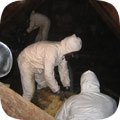 |
|
| I visited my friend Matt in Massachusetts, and he brought me to one of his attic cleanout jobs. This attic was filled with bat droppings, or guano, due to an infestation of Big Brown Bats. It's important to remove the droppings, because they not only smell bad, but can grow mold over time, mold that can cause lung diseases for the inhabitants of the house. The insulation in the attic was also sub-par, so Matt decided to remove all of the droppings and insulation, clean the attic, and add new insulation. I helped out on the day that we removed the droppings and insulation. ...click for more |
06.17.2006 - Nine Banded Florida Armadillo
 |
|
| Today I happened across one of Florida's more unusual creatures, the Nine-Banded Armadillo (Dasypus novemcinctus). It was crossing a parking lot. Instead of running it over with my truck, I decided to photograph it. It
was making pretty good time for an armadillo, purposefully striding across the pavement. Usually they slowly root along, sniffing for snacks to dig out of the ground. However, this armadillo must have sensed that it
would have difficulty digging through the pavement, so it decided to trot along to softer pastures. Since I've already explained why armadillo ...click for more |
06.15.2006 - Dead Baby Oppossums In Wall
 |
|
| First of all, I know that opossum is spelled with one "p", but a lot of internet searchers don't know this, so I decided to spell it with two p's, as
in oppossum, or even opposum, which is also another common misspelling. Regardless, on this day, I removed three dead baby opossums from inside a wall. As usual, I
entered a home that had a bad odor. I took a cursory stroll around the home in order to gain a sense of the area of strongest odor. I isolated it to a room or two,
then jumped in the attic to look. Most commonly, the dead animal is somewhere in the attic. I ent ...click for more |
05.30.2006 - Eastern Garter Snake - Not Garden Snake
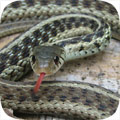 |
|
| The above photo is of an Eastern Garter Snake, (thamnophis sirtalis). This snake is possibly the most commonly sighted
snake in North America. There are many variations of Garter Snake, and the colors and patterns can vary, but for the most part, it's a slender snake with a triangular head,
usually has some form of dark green and tan, and three stripes down the length of the body, on on top and one on each side. This snake is not venomous, and it's the exact same
species that I used to find and pick up and put in a jar and show to my mom for her praise and ...click for more |
05.22.2006 - Baby Bat - Evening Bat
 |
|
| This is a photo of a juvenile bat. The species is Evening Bat. The females usually give birth in mid-April, so this specimen is probably about five weeks old. I found it exactly as photographed here, lying on
its back on the kitchen floor. I hadn't handled a baby bat before, as I do no bat work during the summer maternity season, when the young bats are unable to fly out of the house and therefore unable to fly out of my one-way
bat exclusion nets or funnels. However, in this case the baby bat had wandered down from the attic, through the walls, and out into the house, click for more |
05.21.2006 - Evening Bat Closeup
 |
|
| This is a close-up photo of an Evening Bat - Nycticeius humeralis. I found it in a home here in Florida. It had been living in the attic of the house with the rest of the colony, but a baby bat, possibly
its own, got separated and crawled down the walls of the house, and out into a gap next to the oven vent, and into the kitchen of the home. The adult female bat chased after it, and ended up in the home as well. Once
inside, it had no idea how to get out, and was stuck. I was called by the terrified homeowners and when I arrived, the bat was lying down, exhausted. ...click for more |
05.18.2006 - Pueblan Milk Snake
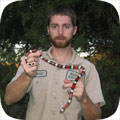 |
|
| I received a call about a Coral Snake in someone's patio. Red, black, and yellow bands, I was told, along with a black nose.
That's a sure description of a Coral, and out I sped to remove the dangerous snake. I showed up to the house, but as is often the case, the snake had left by the time I
arrived. I hate that. I had to drop everything and make a long drive out to the house, and now it had vacated. I scrounged around inside the patio and found nothing, and so
I concluded that it must have slithered out the same way it came in, probably through a gap under the patio ...click for more |
05.10.2006 - Raccoon Bait - What Foods Catch Raccoons?
 |
|
| This blog entry is about what bait is best to trap and remove nuisance raccoons. If you are merely interested in feeding local raccoons, please, PLEASE do
not feed the wildlife. It is a lot of fun and it feels good to do, but it WILL result in animal suffering - critters dependent upon people, increased spread of disease,
unhealthy animals, and starvation when the food source is inconsistent or stops. If you want to know what food to feed a baby raccoon or pet raccoon, I don't advise
keeping them as pets, nor am I an expert in that matter. I'm often asked what bait ...click for more |
05.02.2006 - Tile Roof Repair - Roof Rat Prevention
 |
|
| This was a difficult job. It was a large house with a roof rat problem. The only way to permanently get rid of rats is to seal off all of their entry
holes. This is one of the most difficult types of homes in which to solve the rat problem, because it has a barrel tile roof, and not just that, a barrel tile roof with an open
perimeter. That means that around the edge of the roof are open gaps under every last tile. Rats can enter these wide-open areas at will, and run underneath the
"tunnel" under the tiles and find any opening into the attic, such as where plumbing stacks go through the ...click for more |
04.29.2006 - Florida Black Racer
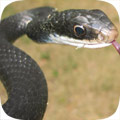 |
|
| Ah, the Southern Black Racer, (Coluber constrictor priapus), the most common snake that I deal with here in Orlando Florida. I estimate that about 40% of all snake calls that I get are due to this one species of snake alone. They are simply
very capable snakes, good at surviging, and they can adapt to a wide variety of habitats. Whereas other snakes inhabit more specific ecological niches, or simply need just the
right protection, Black Racers do fine in a variety of habitats, including suburban and urban. One often has to travel outside of developed Orlando to ...click for more |
04.26.2006 - Raccoons in the Porch Stealing Pet Food
 |
|
| One of the common complaints that I hear from customers is that raccoons are feeding on pet food left outdoors. Duh! If you leave food outside,
animals other than Spot and Fluffy are going to find and eat it. The simple solution, I tell such people, is to take the food indoors, especially overnight, or make sure
that the pets eat all of it. If you do take the food indoors, don't leave it adjacent to a pet door or in a screened-in porch. Raccoons will still be able to smell
it, and now they will break in to get to it. That's what happened at this job today. These two young raccoons ...click for more |
04.24.2006 - Corn Snake
 |
|
| The Corn Snake, Elaphe guttata guttata, is probably the 2nd most common snake that I find and remove here in Central
Florida. I consider it the prettiest snake that I deal with. It has a beautiful red and orange pattern, and the belly is white with black keyboard markings, from which it
gets its name (apparently the markings look like maize, although I'd have named this snake the piano snake on the basis of its belly). Many people associate brightly colored
animals with poison, and it's true that many critters in nature that choose to stand out via their coloring, which is ...click for more |
04.21.2006 - Horrible Smell Inside of a Building - How to Get Rid of Bad Odor
 |
|
| This was an interesting job. I perform dead animal removals on a nearly daily basis. The jobs are always the same - someone calls me with a horrible odor inside the home or
building, and suspects that it's a dead animal carcass, and they call me out to address the problem. Most of the time it is a dead animal. However, every now and then the odor is from a different source. Sometimes it's
rotting meat - such as the bag of rotting hamburger meat I once found on top of a fridge, the rotting chicken I found behind a stereo, or the rotting and forgotten steak inside a micro...click for more |
04.20.2006 - Snake Removal at Carrot Top’s House
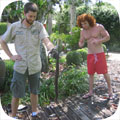 |
|
| This was actually my second time to this customer's house in Winter Park, part of Orlando FL. Both times his assistant and
himself referred to him as Scott, but I recognized him as the prop comedian who goes by the name Carrot Top. I guess he's kind of hard to miss, and the walls of his house are
adorned with various Carrot Top propaganda. My first call to his home came because he had a terrible odor in his house. I knew that it was a dead squirrel. His house was large
with a very complex architecture, and the area of the attic above the room with ...click for more |
04.16.2006 - Female Opossum With Babies on Her Back
 |
|
| This is one of the things that opossums are well-known for. A group of baby opossums clinging to the back of the mother opossum. This kind of thing is common at this time of year, mid-April, because the female possums have their young in the late winter and early
spring, and by this point, the young are grown to a size large enough to spend most of their time outside of the pouch and clinging directly to the back of their mother. It's actually an interesting game of survival. The female opossum has 13 nipples. So at the very beginning, there's
competit ...click for more |
04.05.2006 - Removal of a Critter in the Attic
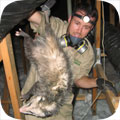 |
|
| Sean and I went to this home today because the customer was hearing noises above his head, and he suspected that he had a critter in his attic. We climbed
the garage ladder hatch and entered the attic, with gloves, headlamps, and dust masks, as usual, and began our inspection. We found plenty of tracks and opossum
droppings, so we knew what critter we were dealing with. Most of the time, we never actually spot the animals in the attic. They quietly hide in the deepest darkest
corners when they sense a potential danger, and they are tough to find. So that's ...click for more |
04.04.2006 - Bat Droppings & Histoplasmosis
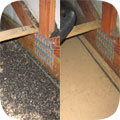 |
|
| Do bat droppings carry the fungus that causes the lung disease histoplasmosis? They certainly can, but it's not as common as some bat removal companies might have their customers think. While it's often
better to err on the side of caution when it comes to biohazards and human health, it's also important not to get carried away. Look at the before and after photo here. This is considered a very minor case of bat
droppings - from a small colony of bats over a short period of time. This accumulation is very unlikely to harbor any fungal growth. The best of ...click for more |
04.03.2006 - Toad Mating
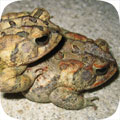 |
|
| I found these fine toads while working in a bat removal project in Heathrow, FL. I don't know what species of toad they are. They're not the regular Eastern Toad, even though that's what they look like, since the range of that toad does not extend
to Florida. I liked how these toads were clearly good pals. They were nearly inseparable. At one point they actually tried to play a game of leapfrog! However, the one frog couldn't quite hop over the other. He tried and tried, but just couldn't make it. The
other frog didn't seem to mind.* Anyway, I took these in-good ...click for more |
04.02.2006 - Little Raccoon
 |
|
| No real point to this blog post except to show off this cute photo of Sean with an adorable little raccoon. It was one of a litter of baby raccoons,
perhaps six weeks old, that we removed from an attic earlier today. We are keeping them in a box, and feeding them kitty formula, and then tomorrow we will bring them to
Lee the wildlife rehabber, and she will raise them until they are large enough to fend for themselves. Raccoons like this one are almost hypnotic in their captivating
power to leave their handlers entranced for hours on end, with their little black masks and ...click for more |
04.01.2006 - Dead Florida Wild Hog in Orlando
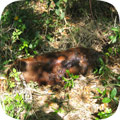 |
|
| I was driving along, singing a song, when suddenly I had to stop driving. For I noticed a scent, and I was hell bent on doing some dead
animal diving. By dead animal diving, I don't mean leaping headlong into a carcass - I mean investigating and photographing the scene of the crime. I got
out of the car and found this wild pig carcass. I suppose, thinking about it now, that this isn't all that interesting. However, it's the only evidence I
have as of now of a wild hog. Sure, I've seen the destruction they cause. They absolutely decimate a lawn when they root through ...click for more |
03.31.2006 - Bat Guano Cleanup in Attic
 |
|
| Today was the cleanup of bat droppings (guano) from the attic of a home. The cleanup is the final step after all of the bats are safely removed and all of the entry points through which the bats could enter the
home are permanently sealed. This was a very simple cleanup case, and not at all bad contamination. First of all, the effected area was above a garage, so I didn't have to deal with any insulation removal. The droppings
were all on the sheetrock. Furthermore, the colony was small, and hadn't been in the attic for long, so the droppings had not accumulated yet. It ...click for more |
03.27.2006 - Baby Possum
 |
|
| I made a baby possum sighting, so I grabbed it and got some fighting, both with scratching and with biting, so now I'll do some possum writing. Baby possum on my shoulder, he is young but I am older, I am shy but he is bolder, my shoulder is a possum holder. Baby possum climbs on me, I am big but he
is wee, he is too young to be set free, he and I will drink some tea. Baby possum tiny tail, tiny hands sized to scale, little bones are thin and frail, he does not
belong in possum jail. Baby possum is a clinger, he hangs around upon my finger, from his tail he is a sw ...click for more |
03.26.2006 - Snake in the House - How to Get it Out
 |
|
| "EEK!! A SNAKE IN MY HOUSE!!" *faint - This scene plays itself out every day in America. A hapless homeowner turns the corner
into the hall, spots a snake lying about, lets out a high-pitched scream and collapses, and then his wife has to come and resuscitate him, nurse him back to health, and send
him off to counseling to get over this traumatic event. The wife then gets the broom and sweeps the snake out the door, and the problem is solved. I deal with snakes inside
homes almost every week. I've seen several different species. In general, the more ...click for more |
03.26.2006 - Squirrel Traps in Action
 |
|
| Here's a fine day's catch of squirrels on an unusually cold March day here in Orlando Florida. The reason I'm catching so many squirrels at this time of
year is because squirrels have their first litter of the year in late January. By late March, the young squirrels are nearly full adult size, and they are running about
wreaking havoc in side attics across the land. This catch came from two different houses today, both in the same neighborhood. This neighborhood has a problem
common to houses in this part of the country - all of the houses are built the same, and thus the ...click for more |
03.18.2006 - Pigeon Contamination from Bird Infestation
 |
|
| This is a serious case of contamination due to pigeon infestation. Worse yet, it occured in a public building, in the primary air duct.
Even worse, it was in a public school. Worse still, the school refused to pay for cleanup, thereby exposing the entire school staff and students to the
diseases that pigeon contamination can bring. Pigeon contamination is serious, and can result in these health risks, such as Histoplasmosis: likely the most common disease
associated with pigeons and bird contamination. Histoplasmosis is a fungal lung disease that is found ...click for more |
03.17.2006 - Do Armadillos Carry Leprosy?
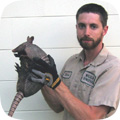 |
|
| One of the bits of wildlife trivia that I'm often exposed to is the one about armadillos and leprosy. Every now and then, a concerned friend/relative or a brilliantly informed customer will inform me that I shant
touch armadillos, because the animal is known to carry the dreaded disease. Well, it's true that armadillos can carry leprosy. It's also true that I handle armadillos all the time. I usually wear gloves, not for
biohazard protection, but because I have clean and dainty hands, and choose not to sully them with armadillodirt. I'm not actually worried that I'll contract leprosy. It's ...click for more |
03.13.2006 - Fat Rat
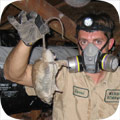 |
|
| I caught a fat rat today. A rotund rodent. A chubby chipmunk, a house of a mouse, a chair-splitter critter. I've never before caught a rat this fat. I checked the traps I set in the attic when I found this round mound. It all started on a Tuesday. On that day, I was
called out to a house in south Orlando. The dame who lived there said that she was hearing noises up in her attic. I didn't hear nothing, and I thought she was cukoo, but I decided I'd take a look up there anyway. Geeze Louise, she wasn't kidding. The attic was a regular rat toilet.
I saw rat turds up there that I never seen bef ...click for more |
03.12.2006 - Rat Poop Droppings & Waste in Attic
 |
|
| Here are two different photos of rat poop in an attic. On the left is a heavily-used rat pathway in an attic with blown-in fill insulation. On the right
is a section of scattered droppings in pink insulation. Both attics had a heavy rat infestation, and thousands of droppings scattered throughout. Rats have very
high metabolisms, and they poop a lot perhaps about 20 rat turds per day. Thus, they leave a lot of rat waste in the attics where they live. They also urinate, and the pheromone scent in the
urine and perhaps even the poo attracts new rats to the area. There is one ...click for more |
03.11.2006 - Critter Trapper Education
 |
|
| I was playing darts over Christmas with my new brother-in-law Sean, when he started asking me about my career as a nuisance wildlife removal specialist.
It told him that it was by far the best job I've ever had, and that I look forward to each day. Sean was doing a boring manager's job at the time, and when I described to
him the trapping in attics and wrassling with snakes, that's all he needed to hear, and he asked if he could sign on and train with me, so that he could start his own business
in his home town of Seattle. I told him sure, come on down to Sunny Florida and ...click for more |
03.10.2006 - Dead Animal Under a House
 |
|
| It was a dark and stormy night, except for the sunshine and gentle breeze. I fixed my steely eyes on the mysterious and foreboding abode
that lay before me, knowing what I had to do, but not quite ready to do it. Then I put on my blue suit and mask and head lamp, and I was in fact quite ready.
I found the secret portal to the labyrinth below the forbidden fortress, and said the secret password: "Open". The password didn't work, so I used my hands
instead of my larynx and removed the crawlspace door. I took a deep breath and started to crawl inside. But I had to let ...click for more |
03.10.2006 - Raccoon Active During the Day - Rabies?
 |
|
| One of the most common myths regarding wildlife is that a raccoon active during the daylight hours has rabies. That is just not true. I constantly receive phone calls from people who have spotted a raccoon active during the daytime, and they assume it
must be rabid, and they call me to report this information and perhaps request that I come and remove the dangerous animal. Raccoons are primarily nocturnal animals, but
the truth is that they do frequently forage during the daylight hours as well. In particular, raccoons that haven't found enough to eat, or females who ...click for more |
03.03.2006 - Squirrels in a Vent Pipe
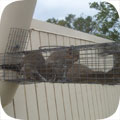 |
|
| This is an office building here in Orlando. The workers have been hearing a lot of noise up in their ceiling, all sorts of running about all day long.
Most of the time, noises during the daytime means squirrel activity. Other attic critters, such as rats or raccoons, are active at night. I came out to the building to
inspect, but I had trouble finding an opening for squirrels to get into the building. Everything was sealed tight, no open holes or chewmarks. The only thing I saw
amiss was a rip in a metal vent pipe. I thought that the pipe must be solid, with no opening into the ...click for more |
03.01.2006 - Snake Caught on a Glue Trap
 |
|
| What do I do when a customer calls about a snake in a home, but I am unable to find it upon my arrival? I set a glue board trap. This is the only effective trap that I know of for snake removal. I've
heard of funnel-type traps, and I suppose that they might work, but probably not as well as a glue trap. Before you set a glue trap for snakes, here are a few things to know: 1)YOU DON'T NEED TO KILL THE SNAKE. Once the
snake is caught on the glue trap, take it outside, and pour some vegetable oil on the snake - or spray PAM cooking oil, and the snake will wiggle itself free. ...click for more |
02.25.2006 - How to Catch an Armadillo by Hand
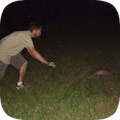 |
|
| When the armadillos get going, and I have no traps at my disposal, I have only one option - to chase them down with my bare hands, leap
upon them like a mighty lion, wrestle them to the ground, and then lose my grip on them and watch them flee into the forest. One might think that armadillos
are slow - what with the shell and all (snails, tortoises, clams) but no, they're quick little buggers. They scoot along in a series of quick, powerful hops.
I scoot along after them in a series of clumsy, awkward hops. Once I get near, the armadillo changes direction and ...click for more |
02.18.2006 - City Raccoon - Urban Raccoon Control
 |
|
| Cities are chock-full of raccoons. It's this way not only down here in Florida, but all over the country. Raccoons have become urbanized city
dwellers. They used to stay only in the undeveloped forests. But raccoons are intelligent and adaptable animals, and they have learned that cities make a great
place to live. There's plenty of tasty garbage and pet food to eat, not to mention that handouts that some people insist on giving them (a dumb thing to do, and
ultimately unkind to animals). And there's also lots of great places to live that are far better than trees. From under ...click for more |
02.11.2006 - Rodents in the Attic
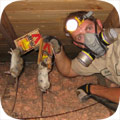 |
|
| Here I am, on a typical rodent in the attic job. This suburban house had a fairly large rodent infestation in the attic. The rats were climbing the walls of the house and chewing their way into a wooden eave, which had a relatively flimsy screen for a vent. It
was easy for the rats to detect the attic space, and to chew their way in. Rodents often seek out attics to live in for many reasons. The primary reason is for a warm, safe, dry, place in which to live. The rats can smell the air of the attic, they can detect the airflow
with their whiskers, and they know that there's a cavity in ...click for more |
02.06.2006 - Wild for Notre Dame! Irish Raccoons
 |
|
| Cheer cheer for old Notre Dame, Baby raccoons are relatively tame, Thus you can stick a hat on their head, And replace Charlie Weis as coach instead. What
thought the coons be great or small, Into your attic they always crawl, While your loyal wildlife trapper dresses them for victory. Yes, these little fellows are now
Notre Dame fans. I showed them the Notre Dame - Pittsburgh game, and raccoons are a natural enemy of panthers, so they decided to side with the Irish. One of them
scampered up my pant leg and stole my ND hat and put it on his head, while the other ra ...click for more |
02.03.2006 - Bat Removal in St. Petersburg
 |
|
| I recently completed this large and difficult bat removal project in St. Petersburg, Florida. This is a 4-story condominium, with a very tall roof, and a barrel tile mansard roof lining the perimeter. The
tiles featured, as many do, wide open gaps across the entire face of the mansard roof. Literally thousands of gaps, everywhere - at the top row of tiles, the bottom row, and around each and every tile. Bats need only
about 3/8 inch of space to get in and out, so this building required a tremendous amount of work, as is usually the case with barrel tile roofs. Though the sealing is ...click for more |
01.26.2006 - Project at SeaWorld Orlando
 |
|
| I took these photos of killer whales at SeaWorld in Orlando. This was during a bat removal project. A colony of Brazilian Free-Tail bats was living in the jumbotron structure overlooking the main display
tank at the Shamu Stadium. SeaWorld usually uses a specific company for their wildlife and bat removal needs, but this particular project was deemed too difficult for their regular bat removal company, so I was called in.
The job was unique for a number of reasons. First of all, the tower was surrounded by ....water. Ladders don't hold as steady on water as they ...click for more |
01.21.2006 - Photo of Bats in Flight
 |
|
| Do you like photos of bats in flight? Sure, we all do! They're hard to get, because bats fly at night, and cameras don't work as well at night. In fact, most people only get to see stray bats here and there, fluttering
about vaguely in the dark dusky sky - or flashing around a street lamp. It's not often that folk get to see a swarm of bats. Thus, it can be hard to get photos of bats on the wing. Unless of course one is sitting on the
roof of a condominium in which a thousand bats are going in and out. Then it's easy to photograph lots of bats. I like to look at the shots of the bats on the ...click for more |
01.20.2006 - Pigeon Control at Orlando Car Dealership
 |
|
| An Orlando area car dealership called me with a common urban problem: pigeons. The pigeons were roosting in several areas of the dealership, most notably on the raftors in the parking garage and on the concrete wall
above the showroom doors. The problem with pigeons is that they eat, which often means that they eventually poop. Pigeon poo is a problem. It's not just unsightly, it's caustic, and corrosive. This means that the pigeon
droppings that fell on the cars in the parking facility actually damaged the paint jobs of these new autos. A manager at the dealer ...click for more |
01.18.2006 - Raccoon Questions and Answers
 |
|
| I found your sight through a Google search and have a question... actually any advice you might be able to give. I'm located in the NW suburbs of Chicago & have had a raccoon mamma raccoon with her kits in my attic now, for aprox 18 days. She had the babies probably about
14 days ago ( that's aprox when I heard for the first time, the babies chattering). The raccoon entered my attic ( and is currently entering & exiting at night only ), from the front roof louvres... which she tore apart a wide enough opening. I've seen her numerous
times at night, come in and out of the ...click for more |
01.13.2006 - Poisonous Snakes Of Florida
 |
|
| There are six species of poisonous snake in Florida. Before I continue and describe them, I'll state that the correct term is actually venomous (a specific type of toxin that's actively injected) and not poisonous (any toxin absorbed via touching, eating, or
breathing), but of course I realize that many people aren't familiar with the difference, and are thus searching online for information on poisonous snakes. I'll also point out that poisonous snakes are relatively rare compared to non-poisonous ones. I think there's about 45
species of snake in Florida, and only 6 are pois ...click for more |
01.12.2006 - Squirrel Relocation
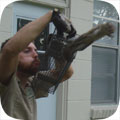 |
|
| Squirrels can be stubborn. Sometimes I try to release them, and they won't leave their cages. In fact, that's often the case for opossums and
armadillos as well. When I get a stubborn animal, I have a special trick. I blow on them! That's right, one good huff and puff, and out they go! Most
of the time, I relocate animals about 20 miles outside of the city to a wilderness preserve area. However, I was set to leave Orlando for a few days, and I had no other
animals to relocate, so I released this one in my back yard. Of course, this was over ten miles from the capture ...click for more |
01.10.2006 - Mouse Vs. Rat - How to Tell The Difference
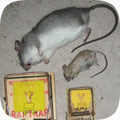 |
|
| Rats and mice are similar in appearance. In fact, people often confuse juvenile rats for mice, and the two do look extremely similar. While there are several species of rats and mice, I will examine the two most common ones, the Roof or Black Rat, and the House Mouse,
both seen in the above photograph. As you can see, the biggest difference is size. Rats grow to a body of 8 inches and a tail of 9 inches, and a weight of almost a pound. Mice rarely grow more than 3 inch body 3 inch tail, and a couple of ounces. Next is color,
and rats tend to be gray with white ...click for more |
01.03.2006 - Emergency Rat Shooting
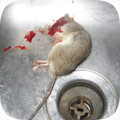 |
|
| I suspect David in the kitchen with the air rifle. I have learned, through ample experience, that the best way to get an "emergency" rat in the house is with the pellet gun. Here's how it works: Every now and then I get a call at 2:00 AM from a panting, stammering homeowner,
who informs me, between gasps for air, that there's a RAT in the house. The homeowner also informs me that I am to come and get it immediately. At this point I will either grumble and mumble something about the rat being
harmless, roll over and fall back asleep, or I'll grumble and get ...click for more |
01.02.2006 - A Dead Opossum in the Ceiling
 |
|
| Some dead animal removal jobs are very challenging - they involve persnickety housewives who recoil at the smell of day-old milk, and can
somehow sense a dead flea in the wall on the other end of the house. I arrive, can't smell anything above the scent of 50 sticks of incense and 30 lavender
candles, but persist on until I find the littlest critter tucked away in some impossible to find god-forsaken back corner of the house, barely raising the
slightest perceptible odor. Those are the lousy dead animal removal jobs. This one, this one was a pure pleasure. It was easy to ...click for more |
|


